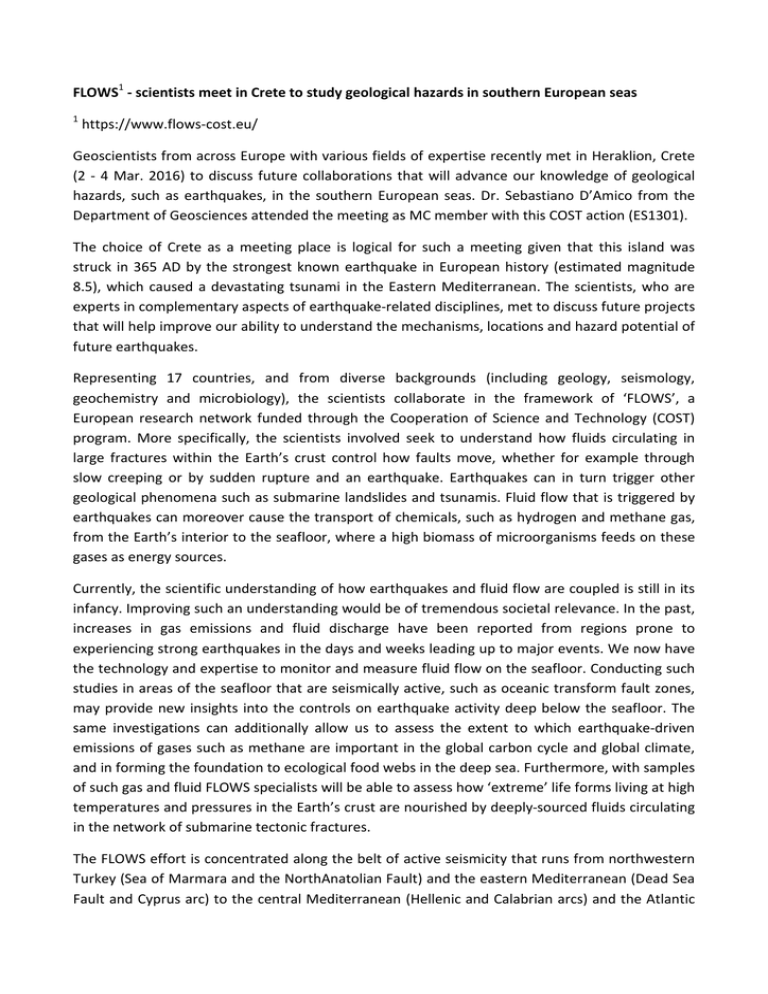FLOWS - scientists meet in Crete to study geological hazards in... -cost.eu/ Geoscientists from across Europe with various fields of expertise recently...
advertisement

FLOWS1 - scientists meet in Crete to study geological hazards in southern European seas 1 https://www.flows-cost.eu/ Geoscientists from across Europe with various fields of expertise recently met in Heraklion, Crete (2 - 4 Mar. 2016) to discuss future collaborations that will advance our knowledge of geological hazards, such as earthquakes, in the southern European seas. Dr. Sebastiano D’Amico from the Department of Geosciences attended the meeting as MC member with this COST action (ES1301). The choice of Crete as a meeting place is logical for such a meeting given that this island was struck in 365 AD by the strongest known earthquake in European history (estimated magnitude 8.5), which caused a devastating tsunami in the Eastern Mediterranean. The scientists, who are experts in complementary aspects of earthquake-related disciplines, met to discuss future projects that will help improve our ability to understand the mechanisms, locations and hazard potential of future earthquakes. Representing 17 countries, and from diverse backgrounds (including geology, seismology, geochemistry and microbiology), the scientists collaborate in the framework of ‘FLOWS’, a European research network funded through the Cooperation of Science and Technology (COST) program. More specifically, the scientists involved seek to understand how fluids circulating in large fractures within the Earth’s crust control how faults move, whether for example through slow creeping or by sudden rupture and an earthquake. Earthquakes can in turn trigger other geological phenomena such as submarine landslides and tsunamis. Fluid flow that is triggered by earthquakes can moreover cause the transport of chemicals, such as hydrogen and methane gas, from the Earth’s interior to the seafloor, where a high biomass of microorganisms feeds on these gases as energy sources. Currently, the scientific understanding of how earthquakes and fluid flow are coupled is still in its infancy. Improving such an understanding would be of tremendous societal relevance. In the past, increases in gas emissions and fluid discharge have been reported from regions prone to experiencing strong earthquakes in the days and weeks leading up to major events. We now have the technology and expertise to monitor and measure fluid flow on the seafloor. Conducting such studies in areas of the seafloor that are seismically active, such as oceanic transform fault zones, may provide new insights into the controls on earthquake activity deep below the seafloor. The same investigations can additionally allow us to assess the extent to which earthquake-driven emissions of gases such as methane are important in the global carbon cycle and global climate, and in forming the foundation to ecological food webs in the deep sea. Furthermore, with samples of such gas and fluid FLOWS specialists will be able to assess how ‘extreme’ life forms living at high temperatures and pressures in the Earth’s crust are nourished by deeply-sourced fluids circulating in the network of submarine tectonic fractures. The FLOWS effort is concentrated along the belt of active seismicity that runs from northwestern Turkey (Sea of Marmara and the NorthAnatolian Fault) and the eastern Mediterranean (Dead Sea Fault and Cyprus arc) to the central Mediterranean (Hellenic and Calabrian arcs) and the Atlantic coasts of Europe, just beyond the Straits of Gibraltar (the Rif - Betic Arc). Monitoring of key variables, such as seismicity, quantity and quality of fluids flowing into and out of the crust through the effect of pressure changes due to tectonic stresses are considered important steps forward towards better anticipating future earthquakes. By bringing together leading scientists from different fields of earthquake-related sciences, and thereby stimulating cross-disciplinary discussions and collaborations, FLOWS offers the hope that traditional barriers between the different fields in the geosciences can be overcome, and an integrated understanding of the main drivers and ecological consequences of earthquakes achieved. Already, the multidisciplinary approach adopted by the FLOWS community has been used to produce an inventory of the most hazard-prone geological areas and to propose innovative techniques for monitoring seismic activity and fluid flow at and below the seafloor. Preliminary results of the project are encouraging, but an important goal will be to translate theoretical knowledge into practical outcomes, such as the mitigation of geological risks in tectonically active areas. This next phase will require coordination at the EU level, and further funding to promote technological progress towards ‘early warning’ strategies, the ultimate goal of this project, which can be tested in tectonically well-characterized regions, such as the Sea of Marmara. FLOWS delegates examine beach rocks on Crete’s southern shore uplifted by the action of past earthquakes.





